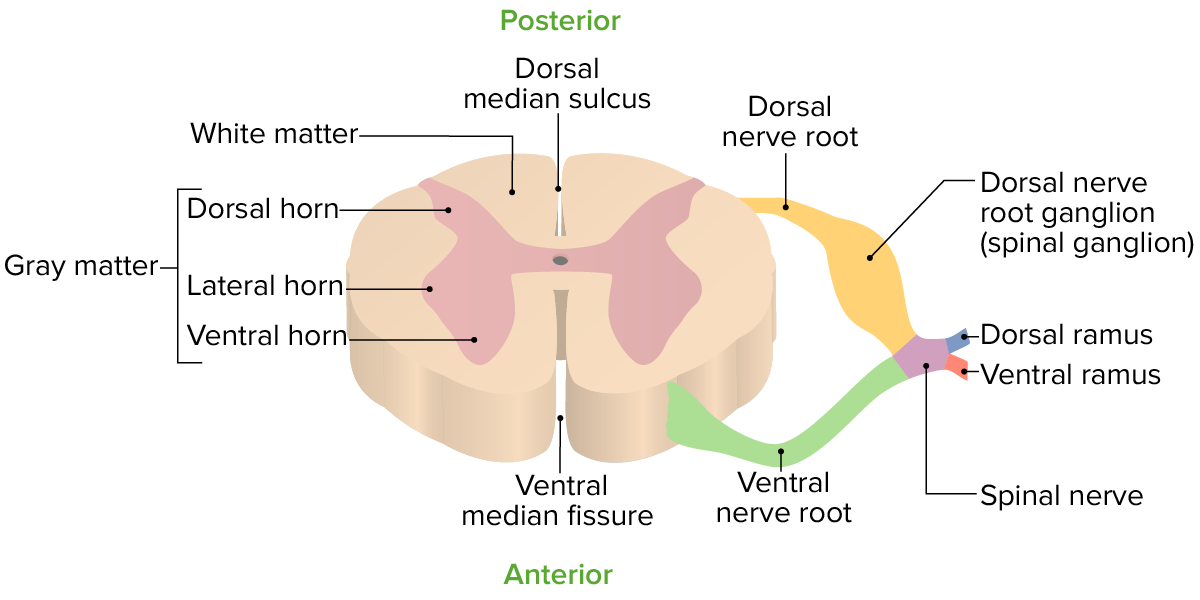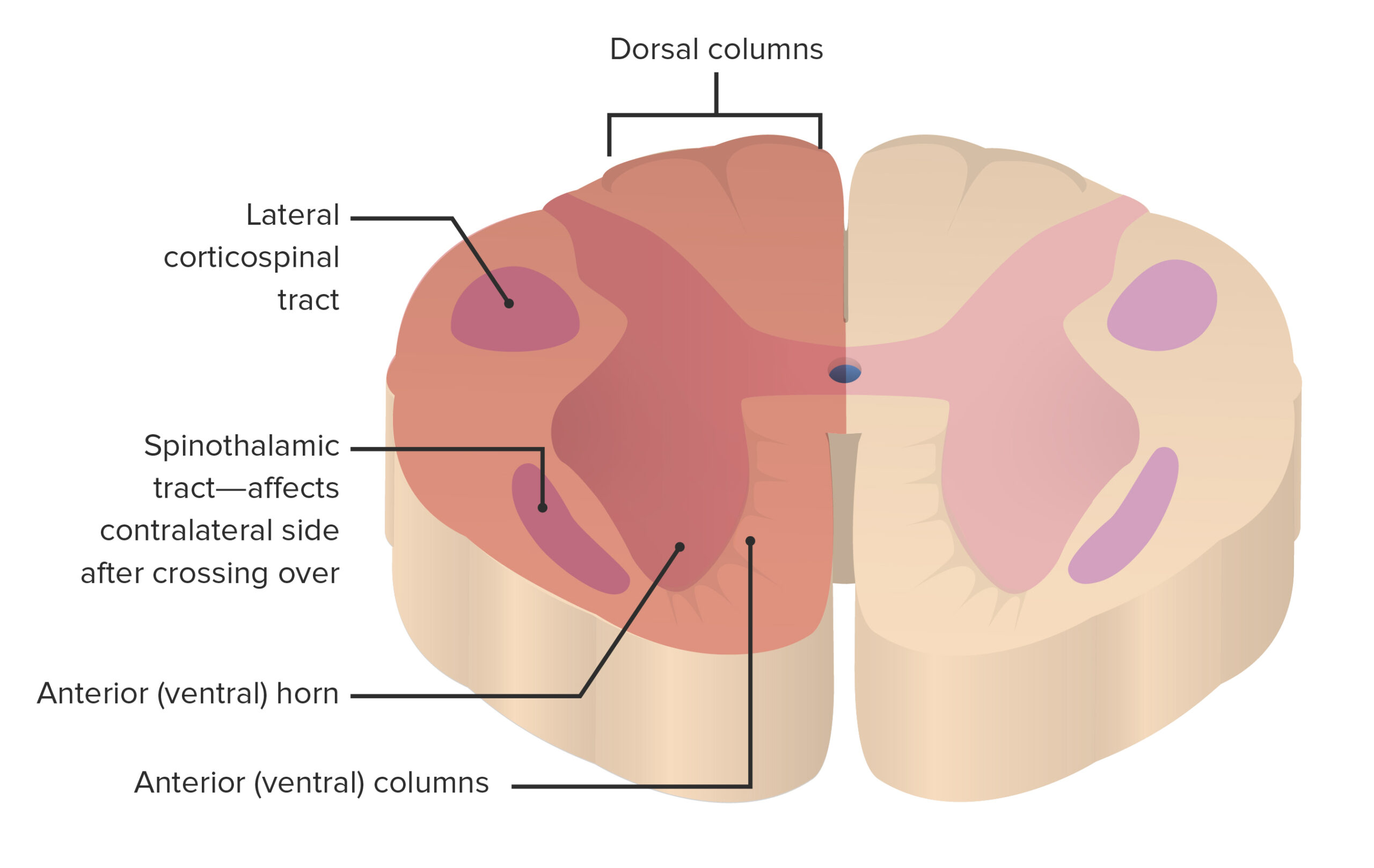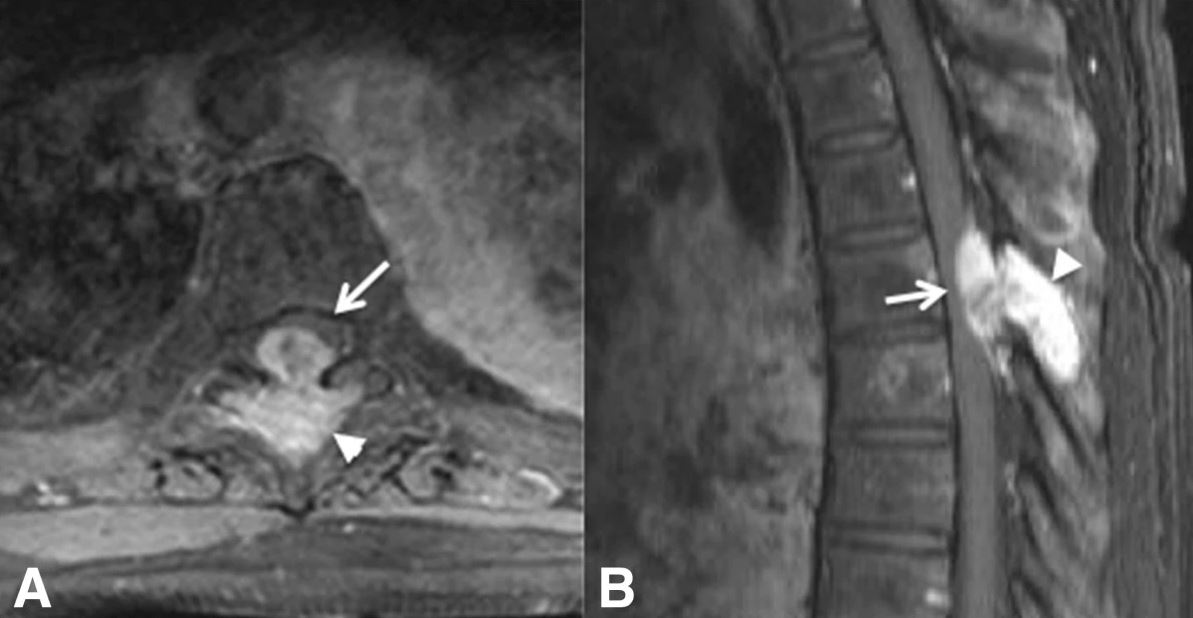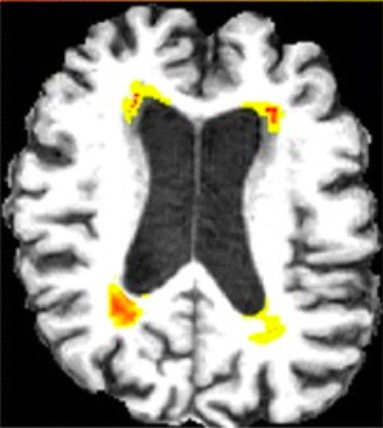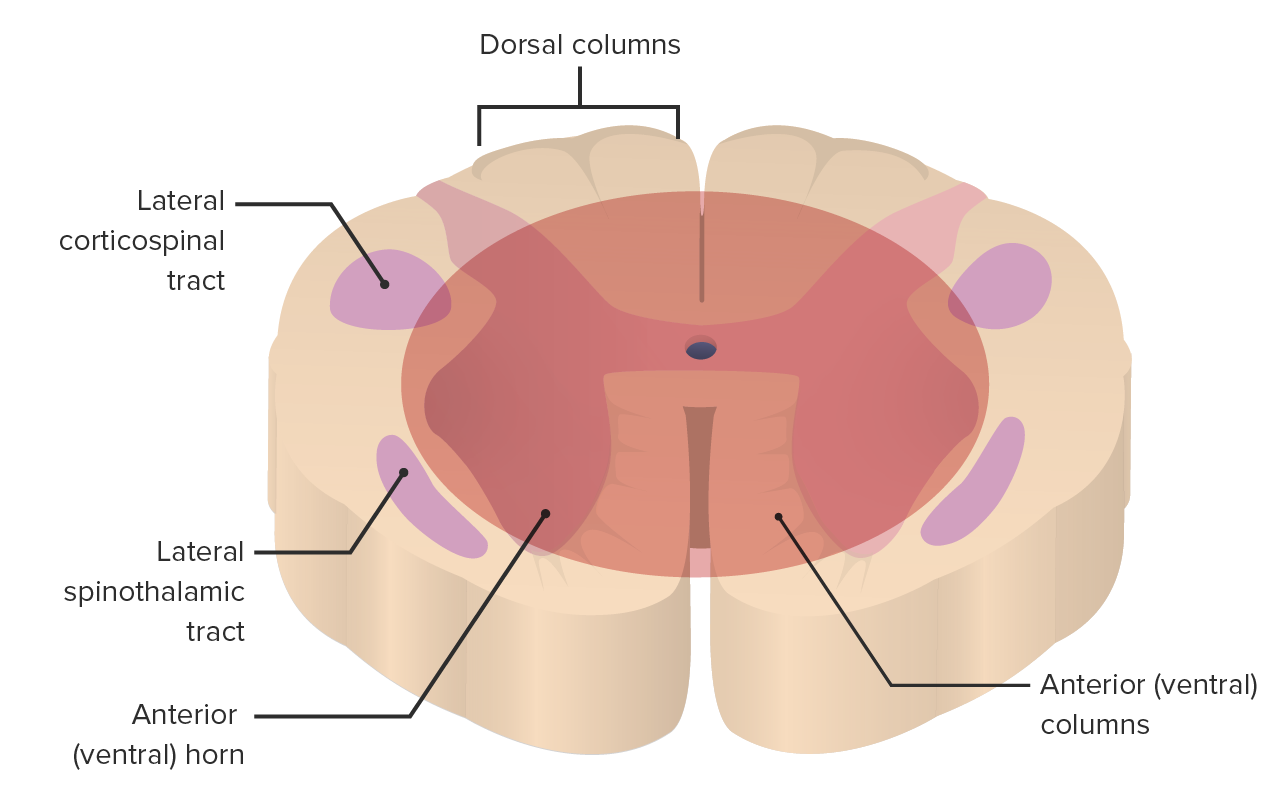Playlist
Show Playlist
Hide Playlist
Spinal Cord Syndromes
-
Slides SpinalCordSyndromes Surgery.pdf
-
Download Lecture Overview
00:01 Thanks for joining me on this discussion of spinal cord syndromes in the section of neurosurgery. 00:07 Remember, spinal cords can be a little confusing, but they’re incredibly high-yield information for examinations. 00:13 And frankly, they’re kind of fun to talk about. 00:16 Let’s begin. 00:17 We can’t talk about spinal cord syndromes unless we have a basic understanding of the important spinal columns. 00:24 Here, I'll describe to you three very important spinal columns, so that you can understand when one of them is injured what the resulting pattern would be. 00:35 Focus on the green areas for now. 00:37 In the dorsal space or the back of the spinal canal is a dorsal column. 00:42 It’s important for sensory and ascending pathways. 00:46 And the anterolateral system is also important for sensory and ascending pathways. 00:51 Now, take a look at the pyramidal tracts on the left side of the screen. 00:55 We’ll go over each of these individually. 00:58 First, let's start with the corticospinal tracts. 01:01 You may get confused with some of the nomenclature. 01:03 Not to worry. 01:04 I’m going to go through these slides one time and then we’ll repeat it just to stress to you that sometimes it can be confusing and it’s helpful to look at it several times. 01:13 Under the pyramidal tracts are the very important motor and descending pathways called the corticospinal tracts. 01:20 It's highlighted here in the circle. 01:23 The corticospinal tracts are very important for motor function. 01:27 That motor function is, of course, at the level below where it inserts. 01:33 Next, let's visit the dorsal columns. 01:36 The dorsal columns are part of the sensory and ascending pathways and controls proprioception and fine touch. 01:48 Lastly, the spinothalamic pathway. 01:51 The spinothalamic pathway is part of the anterolateral system, highlighted here in the circle. 01:57 The spinothalamic pathway is very important for pain and temperature sensation and also carries the crude touch. 02:05 Now, let’s repeat. 02:07 Again, corticospinal tracts are part of the pyramidal tracts and are responsible for motor function. 02:13 Next, dorsal columns are important for proprioception and fine touch. 02:19 And lastly, the anterolateral system, including the spinothalamic pathway, is important for pain and temperature. 02:28 This becomes very important, particularly when we start talking about the incomplete spinal syndromes. 02:33 Here we go. 02:35 First, Brown-Séquard syndrome. 02:36 Then anterior cord syndrome. 02:40 And last, central cord syndrome. 02:43 We’re going to discuss all of these and findings that are classic for these incomplete cord syndromes. 02:49 You'll probably want to look at these slides several times to commit them to memory. 02:55 Let's begin with Brown-Séquard syndrome. 02:58 Brown-Séquard syndrome is due to a hemi-transection of the spinal cord. 03:02 Due to this hemi-transection of the spinal cord, you can go back to the previous slides and figure out which of the tracts are affected. 03:12 The findings include ipsilateral upper motor neuron paralysis and loss of proprioception, as well as contralateral loss of pain and temperature sensation. 03:20 The reason for this is because the spinothalamic tract crosses. 03:23 There can also be ipsilateral Lower Motor Neuron Lesion signs at the level of the lesion due to injury of the Anterior horn cells. 03:32 Next, let's visit the anterior cord syndromes. 03:36 The anterior cord syndromes, as the name implies, involves ischemia or injury to the anterior cords. 03:43 So, the dorsal column is spared. 03:45 Remember, dorsal column is important for proprioception and fine touch, which is preserved. 03:52 Anterior cord syndrome is injury to the spinothalamic tract. 03:56 Remember, it's part of the sensory and afferent pathway. 04:01 This results in ipsilateral loss of motor pain and temperature sensation. 04:05 Recall, due to the distribution of the anterior cord syndrome, sometimes a corticospinal tract is also involved, thus explaining the loss of motor. 04:16 Lastly, we want to talk about central cord syndrome. 04:21 Central cord syndrome usually occurs in elderly patients, particularly in trauma with cervical spine injury. 04:29 Central cord syndrome, usually in elderly patients because they may have pre-existing cervical stenosis. 04:36 It is classified as a hyperextension injury. 04:40 And the neurological exam shows preferential sparing of the lower extremities and weakness in the upper extremity. 04:48 Remember, though, there's actually varying degrees of sensory loss. 04:51 It's not a very reliable exam for the central cord syndrome.
About the Lecture
The lecture Spinal Cord Syndromes by Kevin Pei, MD is from the course Special Surgery. It contains the following chapters:
- Spinal Cord Syndromes
- Incomplete Cord Syndromes
Included Quiz Questions
Which of the following tracts carries pain and temperature sensation?
- Lateral spinothalamic tract
- Dorsal column medial lemniscus
- Lateral corticospinal tract
- Anterior corticospinal tract
- Pyramidal tracts
Which of the following findings are CORRECT in cases of Brown-sequard syndrome?
- Contralateral loss of pain and temperature sensation
- Ipsilateral loss of pain and temperature sensation
- Contralateral upper motor neuron paralysis
- Contralateral upper motor neuron paralysis and contralateral loss of temperature sensation
- Contralateral loss of proprioception and ipsilateral loss of pain sensation
Anterior cord syndrome leads to which of the following clinical findings?
- Loss of motor, pain, and temperature sensation at and below the lesion
- Contralateral loss of motor sensation above the level of the lesion
- Loss of deep touch and vibratory sensation below the level of the lesion
- Ipsilateral lower motor neuron paralysis
- Ipsilateral loss of pain sensations above the level of the lesion
Customer reviews
5,0 of 5 stars
| 5 Stars |
|
1 |
| 4 Stars |
|
0 |
| 3 Stars |
|
0 |
| 2 Stars |
|
0 |
| 1 Star |
|
0 |
Easy, concrete explanation, delivers what is needed without loosing the viewer during the video

